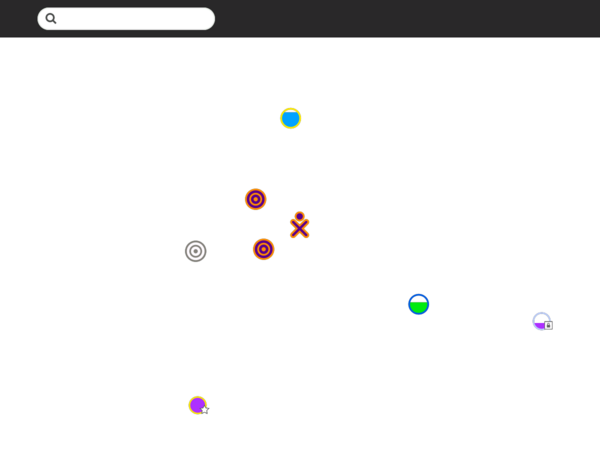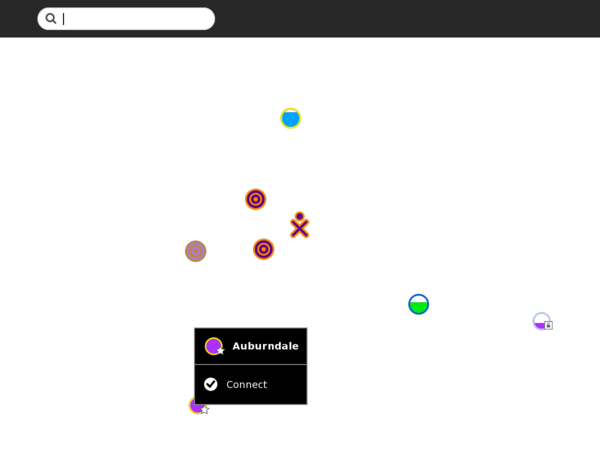Homepage | Activities | Events | Lists | Development | Translate | Contact
Difference between revisions of "User:Walter/sandbox/Connecting"
| Line 24: | Line 24: | ||
====Step 2: Choose an access point==== | ====Step 2: Choose an access point==== | ||
| − | [[#Step 1: Go to the Neighborhood view | back]] | [[# | + | [[#Step 1: Go to the Neighborhood view | back]] | [[#Step 3: Activate a connection | next]] |
{| | {| | ||
| Line 32: | Line 32: | ||
Networks (access points) are represented by circles on the Neighborhood view. Networks can be identified by hovering over the circles: an access point is identified by its name (ESSID); a mesh-portal point—represented by a series of concentric circles—is identified by its channel number (1, 6, or 11). You can also search for an access point by name in the search bar at the top of the page. <br/> <br/> | Networks (access points) are represented by circles on the Neighborhood view. Networks can be identified by hovering over the circles: an access point is identified by its name (ESSID); a mesh-portal point—represented by a series of concentric circles—is identified by its channel number (1, 6, or 11). You can also search for an access point by name in the search bar at the top of the page. <br/> <br/> | ||
| − | Signal strength is indicated by the fill-level of the circle. The color of the circle is based upon the name of the access point. Networks that are locked are identified by a badge. Access points that have been previously used (favorites) are identified by a star | + | Signal strength is indicated by the fill-level of the circle. The color of the circle is based upon the name of the access point. Networks that are locked are identified by a badge. Access points that have been previously used (favorites) are identified by a star. |
| − | |||
| − | |||
]] | ]] | ||
|} | |} | ||
| + | |||
| + | ====Step 3: Activate a connection==== | ||
| + | [[#Step 2: Choose an access point | back]] | [[#Step 3: Activate a connection | next]] | ||
| + | |||
| + | To activate a network connection, click once inside the circle that corresponds to your chosen access point (or click on the ✔ Connect option in the hover menu). | ||
| + | |||
| + | (To “click”, press once on the left-hand touchpad button—the button with the × symbol at the front of the touchpad.) While the XO is trying to establish the connection, the inside of the circle will blink. Once the connection is established, the outside of the circle will turn white. If for some reason the connection failed, the circle will stop blinking. Sometimes it is necessary to try several times before the connection is established | ||
| + | |||
| + | If the access point requires a key, you will be prompted. Note that different types of access points require different types of keys: be sure to select the correct type from the pull-down menu that is presented. Some access points (such as the Apple Extreme®) will only work with a hexadecimal value. If you have a password or passphrase, go to Hex Converter to get the hex key. Also, with the Apple Extreme you need to set “shared key”. Most other access points prefer the “open key” setting when using WEP. | ||
| + | |||
| + | Currently, we do not support WPA-enabled WiFi access points; we anticipate including WPA support in early 2008. | ||
Revision as of 11:19, 16 June 2008
Wiki-based Getting Started Guide (based on Joyride 2037)
Getting Connected
There are multiple ways to connect to the Internet:
- wireless access point (WiFi hotspot);
- “School Server” mesh network;
- “simple” mesh network, which lets you collaborate directly with other XOs;
- wired network (may require an external adapter—e.g., see USB Ethernet adaptors).
You make your connection from the Neighborhood view. Your current connection status is shown on the Frame.
Step 1: Go to the Neighborhood view
back | next
| Hint: The Neighborhood view is accessed by clicking on the Neighborhood icon on the Frame or by pressing the F1 key (OLPC-XO-1-specific hint) |
Step 2: Choose an access point
Step 3: Activate a connection
To activate a network connection, click once inside the circle that corresponds to your chosen access point (or click on the ✔ Connect option in the hover menu).
(To “click”, press once on the left-hand touchpad button—the button with the × symbol at the front of the touchpad.) While the XO is trying to establish the connection, the inside of the circle will blink. Once the connection is established, the outside of the circle will turn white. If for some reason the connection failed, the circle will stop blinking. Sometimes it is necessary to try several times before the connection is established
If the access point requires a key, you will be prompted. Note that different types of access points require different types of keys: be sure to select the correct type from the pull-down menu that is presented. Some access points (such as the Apple Extreme®) will only work with a hexadecimal value. If you have a password or passphrase, go to Hex Converter to get the hex key. Also, with the Apple Extreme you need to set “shared key”. Most other access points prefer the “open key” setting when using WEP.
Currently, we do not support WPA-enabled WiFi access points; we anticipate including WPA support in early 2008.

